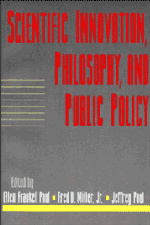Book contents
- Frontmatter
- Contents
- Introduction
- Acknowledgments
- Contributors
- The Human Genome Project: Research Tactics and Economic Strategies
- Choosing Who Will Be Disabled: Genetic Intervention and the Morality of Inclusion
- Germ-Line Genetic Engineering and Moral Diversity: Moral Controversies in a Post-Christian World
- Self-Critical Federal Science? The Ethics Experiment within the U.S. Human Genome Project
- When Politics Drives Science: Lysenko, Gore, and U.S. Biotechnology Policy
- Biotechnology and the Utilitarian Argument for Patents
- Property Rights Theory and the Commons: The Case of Scientific Research
- Property Rights and Technological Innovation
- Medicine, Animal Experimentation, and the Moral Problem of Unfortunate Humans
- A World of Strong Privacy: Promises and Perils of Encryption
- Computer Reliability and Public Policy: Limits of Knowledge of Computer-Based Systems
- Responsibility and Decision Making in the Era of Neural Networks
- Preposterism and Its Consequences
- Index
Property Rights and Technological Innovation
Published online by Cambridge University Press: 04 August 2010
- Frontmatter
- Contents
- Introduction
- Acknowledgments
- Contributors
- The Human Genome Project: Research Tactics and Economic Strategies
- Choosing Who Will Be Disabled: Genetic Intervention and the Morality of Inclusion
- Germ-Line Genetic Engineering and Moral Diversity: Moral Controversies in a Post-Christian World
- Self-Critical Federal Science? The Ethics Experiment within the U.S. Human Genome Project
- When Politics Drives Science: Lysenko, Gore, and U.S. Biotechnology Policy
- Biotechnology and the Utilitarian Argument for Patents
- Property Rights Theory and the Commons: The Case of Scientific Research
- Property Rights and Technological Innovation
- Medicine, Animal Experimentation, and the Moral Problem of Unfortunate Humans
- A World of Strong Privacy: Promises and Perils of Encryption
- Computer Reliability and Public Policy: Limits of Knowledge of Computer-Based Systems
- Responsibility and Decision Making in the Era of Neural Networks
- Preposterism and Its Consequences
- Index
Summary
ECONOMIC DEVELOPMENT, INNOVATION, AND PROPERTY RIGHTS
The economist Armen Alchian said once that ever since the fiasco in the Garden of Eden, we have been living in a world in which what we want exceeds what is available. The desire for more satisfaction is a predictable behavioral implication of the fact of scarcity. In fact, it might have helped mankind to survive against competition from other forms of life. Man's desire for more utility gives rise to two interdependent issues that each and every society has to face: (i) how to increase the value of the community's wealth, and (ii) how to allocate the increment in wealth. We generalize those issues as the demand for economic development.
Innovation means doing something that has not been done before. It could be the production of a new good, the opening up of a new market, the discovery of a new source of supply, the development of a new method of production, or changes in the rules of the game. Whichever is the case, by injecting a novelty into the flow of economic life, innovation offers the community a new choice. Innovation is the engine of economic progress.
Most innovations that affect the economy are technological (scientific) innovations. Technology, broadly defined, embodies the prevailing knowledge. The growth of knowledge then creates new technological possibilities. Since both the growth and the direction of new knowledge are unpredictable, the flow of innovations is also unpredictable and their impact on the economy uncertain.
- Type
- Chapter
- Information
- Scientific Innovation, Philosophy, and Public Policy , pp. 168 - 180Publisher: Cambridge University PressPrint publication year: 1996
- 1
- Cited by



